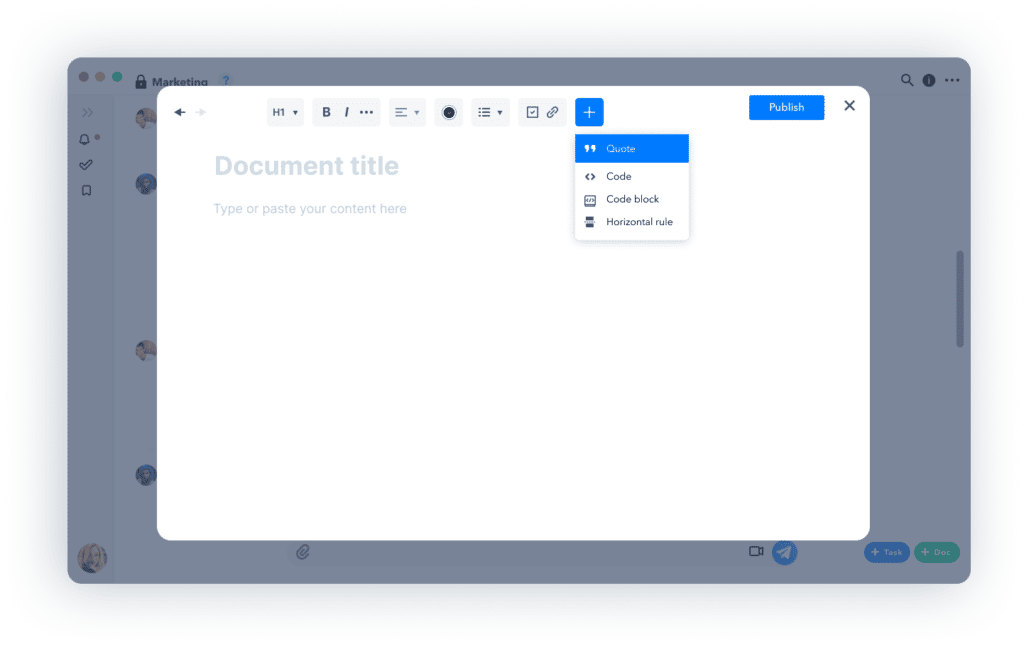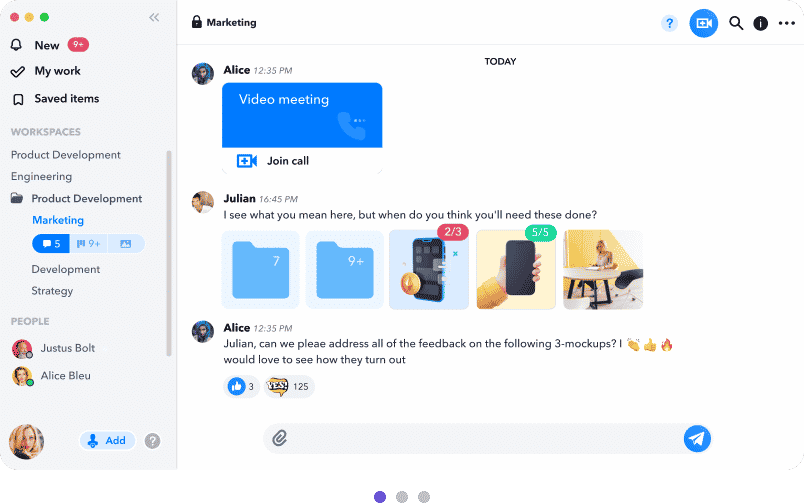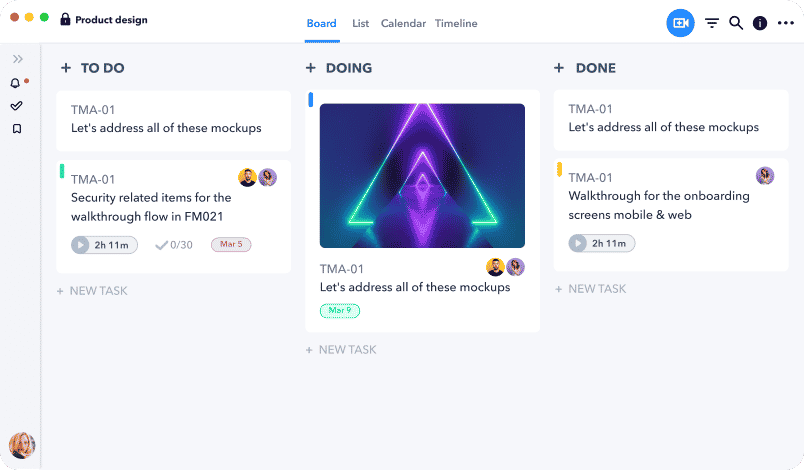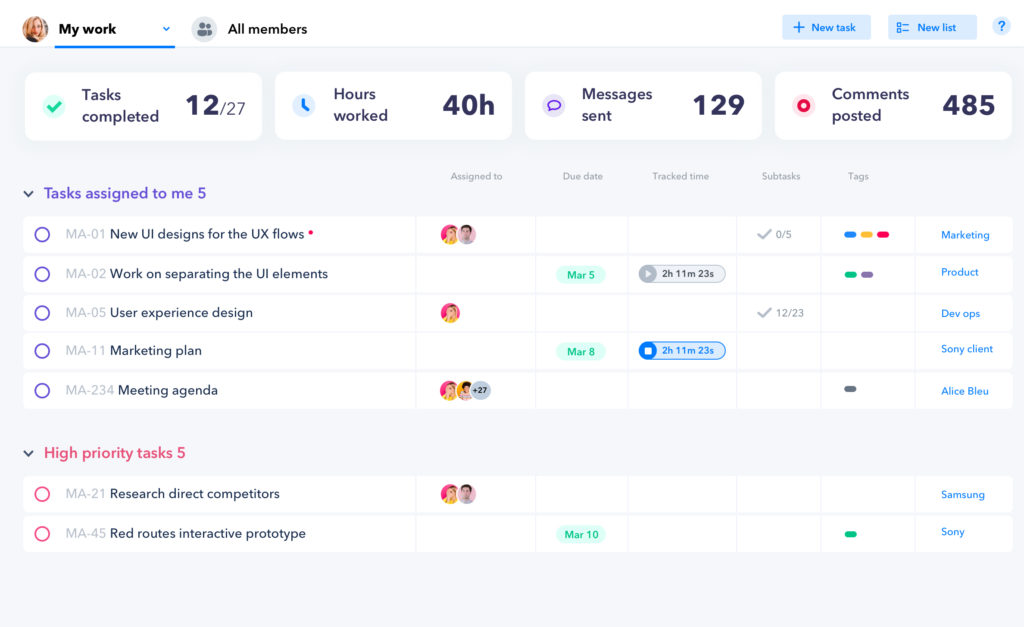What makes a good project management tool?
With the right project management tool for small business, project management can become seemingly effortless. A project management tool for small business, teams, and creatives can make sure that all projects follow an optimal process to meet deadlines while enhancing collaboration and unleashing productivity.
Whether you’re a creative agency or an independent graphic designer, project management tools for creatives can create a transparent record to let everyone know who is responsible for what. But when choosing one, it’s important to go with the best project management tool for your team.
What is a project management tool?
Project management tools are software to help teams conceive, plan, manage, allocate, and optimize resources across a project cycle and throughout an organization. Depending on the domains they focus on and the scale they support, project management tools come in various forms. Here’s what a project management tool for small business usually includes:
- Assigning and tracking tasks: A project management tool will make it easy to assign and monitor tasks in a project.
- Main and supplementary projects: This is how you assign and manage the different supplementary projects under the main project.
- Collaboration: Enhancing collaboration across domains is a fundamental aspect of a project management tool for small businesses.
- Multimedia sharing: A project management tool would also enable teams to share documents and resources.
- Time tracking: Top-rated project management tools allow you to track the time you spend on various tasks of a project.
 Why are project management tools important?
Why are project management tools important?
According to PwC, 77 percent of all high-performing teams use project management tools. The study found that project management is intrinsically linked to project performance.
If you have never used project management software, this fact alone should interest you: Organizations that don’t use them end up wasting 28 times more money. The Project Management Institute (PMI) found out that around $122 million is wasted for every $1 billion invested in the US alone due to the absence of project performance.
KPMG estimates that an astounding 70 percent of all organizations have had at least one project failure. This doesn’t mean that companies are wholeheartedly adopting project management tools. Only about 58 percent of organizations understand and appreciate the need for project management.
These alarming statistics bring to light the most important reason why organizations need project management tools. It leads to less money being wasted on projects. It also helps teams plan their projects with clear objectives, efficient resource allocation, and a functional timeline.
When organizations use project management tools with domain specialization, projects are completed faster, using the right amount of resources, with enhanced collaboration between teams, and according to pre-determined goals. This is what makes businesses agile, innovative, productive, and future-ready.
How to select a project management tool
It’s important to select a project management tool that addresses your category concerns and provides demonstrable value without any complexity. Following these steps will help you choose the right one, whether you’re looking for a project management tool for small businesses or a project management tool for freelancers.
1. Identify your project management needs and problems
Begin by identifying the problems in how your teams work. Is there consistent communication between various departments? Are your projects disorganized? Do your teams frequently miss deadlines? Can you easily understand customer or client feedback?
Are workloads evenly distributed among your team members? Is there too much communication with crowded inboxes and long email threads? Are there unnecessary meetings that slow down the process? Addressing these will help you choose a project management tool for creatives that immediately delivers results.
2. Research available project management tools
After defining your needs and problems, look for available options. You can start with an online search or look for recommendations from websites that focus on your industry. Go through websites that review software and talk to colleagues about project management tools they may have used in the past.
While conducting your research, look for project management tools that specialize in your specific sector and have all the functionalities that your organization would need. A project management tool for small business will be different from one designed for large enterprises.
3. Test the project management tool
Once you finalize the project management tool you need, it’s time to check it out. No matter how advanced the specs sound, nothing can replace the real-life application of the software. If your software has a free version or a free trial, utilize it. In fact, look for project management tools that have such versions or trials.
While trying out, involve teams from different departments and work on an actual project. Use all the features and see if there are bugs or other issues. Also, check the speed and effectiveness of their customer service.
4. Request your team for feedback
The way you analyze a project management tool for small business could be different from a team member or someone in a different department. Feedback from your team members will paint a more realistic picture of the software.
What did your team like most about the tool? Was there anything they were uncomfortable with? Did they find it easy to find the necessary features? Did the tool make their workflow more efficient? These answers will help you finalize your project management tool.

5. Analyze the cost of the project management tool
If you operate alone, you can find a credible project management tool for free or a project management tool for freelancers or small businesses. But if you’re buying a paid version, you should evaluate its cost against its advantages. Since you started by identifying the problems with your current project management, you can know whether the software has made any difference.
If you realize that your projects are getting executed faster with fewer resources, it’s a project management tool that justifies the cost. Secondly, how comfortable are you with the payment structure? Do you have the flexibility to choose from annual or monthly subscriptions? Now you can figure out if it’s a sensible use of your resources.
6. Implement the project management tool
If the features and cost suit your requirements, you can buy the project management tool. After that comes the important part; implementation. Since it’s a new tool, you need to make sure that the rollout is smooth and seamless. Pay attention to the following factors when you implement the new project management tool:
- Timeline: Be clear on whether you will be rolling it out for the entire organization or specific teams and have a viable timeline.
- Training: Have a training program in case your team members need it before they start using the project management tool for small business.
- Ambassadors: Identify key individuals who will advocate the new tool and encourage others to use it.
- Integrations: If you use other software for communication or productivity, figure out how you can integrate them with your new project management tool.
7. Review the performance
It’s important to analyze the performance of your project management tool after its rollout. Was it a smooth implementation? Did your team members find it user-friendly? Ask for opinions from different domains and you will have detailed feedback.
When team members give positive feedback, share it with others. This way, everyone will know the best practices about the new tool.
Features and benefits to look for in your project management tool
Your project management tool for small business should have the following features and benefits. And unlike most tools in the market, Heycollab comes loaded with these.
Documents

It should be effortless for everyone to share and access documents. Heycollab, for example, delivers everything in one place for its users.
Video calling

Why use separate software for video calling when your project management tool can easily enable it? Heycollab’s easy video calling makes it possible for team members to discuss complex details of any task.
Messaging

If your project management tool comes with easy-to-use messaging, your team can finally say goodbye to endless email threads and needless meetings. This will save everyone time and effort and there will be no need for any other communication software.
Project boards

This is how you quickly find out the status of the main project and all its associated tasks. It helps you organize and plan your project and manage the workload of your team members from one place.
Time tracking

If your project management tool for small business can help you track time, you will meet your project deadline. Once you find out how much time you take for specific tasks, you can plan projects more effectively in the future.
Importing
A good project management tool will enable effortless importing of all documents and resources needed for all the tasks and easily integrate with any other software you use.

In short
With the right project management tool for small business, you will not just be managing your projects in a more effective way. You will also be empowering your team members to be more productive, creative, and result-oriented. This will help your organization stay innovative and competitive.
————-
Heycollab is a project management tool built for teams like yours. With a free 14-day trial you can try out all the cool features. To get started visit https://heycollab.com/

